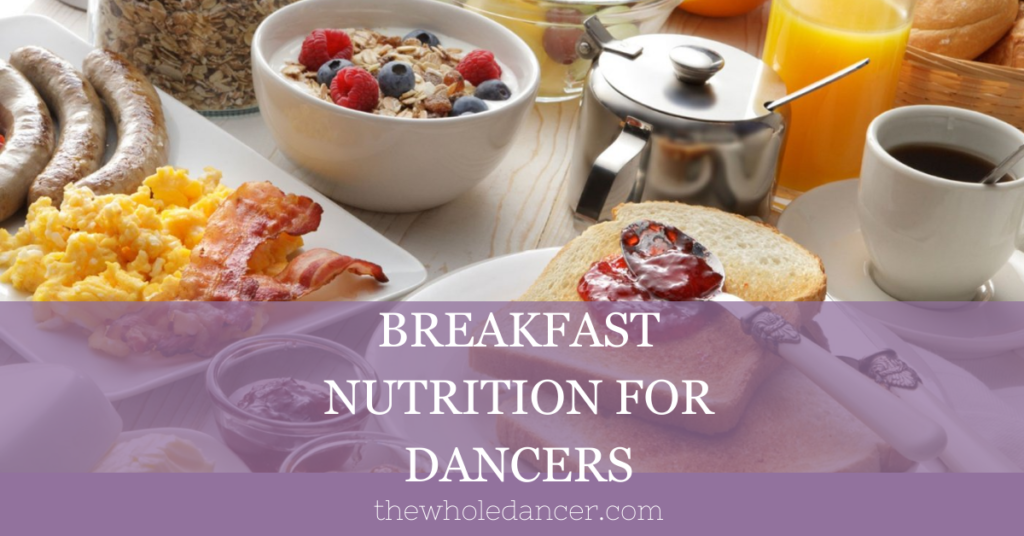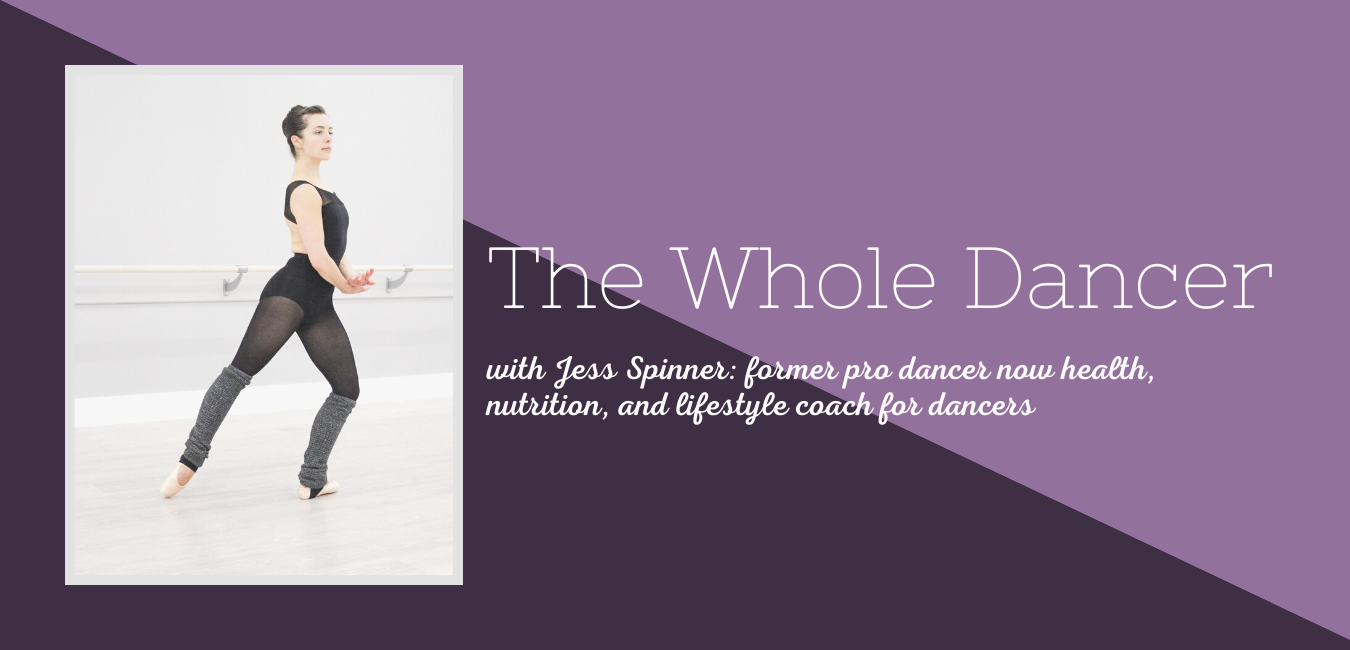Importance of Breakfast Nutrition for Dancers
Breakfast is a key meal in a dancer’s day. It’s an opportunity to give your body lots of fuel to power through hours of classes, rehearsals, and performances. Your first meal of the day can help you to feel energetic even later in the day.
You’re quite literally breaking the fast your body has been in overnight. Set the stage for the day with a substantial and nutrient-packed breakfast.
Can a dancer skip breakfast?
There are a lot of reasons you might be tempted to skip breakfast or undereat at that meal. You might tell yourself if you eat less in the morning you’ll eat less overall (and while this shouldn’t be the goal, it is the mindset of many dancers).
As it turns out, when dancers don’t fuel adequately earlier in the day, they very often end up eating whatever they can get their hands on at night. The hunger catches up with you, and eating becomes mindless and haphazard.
Many of the dancers I work with notice that when they bulk up their breakfast, they’re able to find a much more balanced approach to lunch and dinner. They also find they’re much less likely to engage in mindless snacking after dinner.
What if you’re just not hungry at breakfast time?
There are things that can come up that impact your a.m. hunger pangs (or lack thereof). Hormones ghrelin (hunger hormone) and leptin (fullness hormone) might naturally be at levels that lower your desire to eat when you first wake up.
If you’re feeling anxious about the day ahead, this too can impact your hunger. One of the more common situations among dancers is that you’ve eaten a larger meal or snacks the night before. If this last scenario describes you, start to shift that habit gradually, and you might start to have an easier time eating more in the morning.
It might be helpful to start with a ginger or peppermint tea, which both can help to settle your stomach. Warm water with lemon is another option to add as it may aid in digestion and make that morning meal feel more physically manageable.
Don’t skimp on any macros at breakfast.
Carbohydrate considerations.
Breakfast is a key time to include carbohydrates, because after a night of sleep, your body is already in need of glycogen (the stored form of glucose we use for energy).
After you eat carbohydrates, your body breaks them down into the sugar glucose for energy. Carbs come in the form of sugar, starches, and fiber. Sugars can provide quick energy, starches generally raise blood sugar more slowly, and fiber slows sugar absorption. These are key considerations as you choose your carbohydrate sources for breakfast.
Some options include whole grain toast, sprouted grain bread like Ezekial, steel cut or rolled oats, brown rice, sweet potatoes, or quinoa.
Protein power.
Your proteins are made up of amino acids, the “building blocks of life.” As you consider your food choices, it’s important to realize that essential amino acids cannot be produced by the body; therefore, they must be acquired through your food. The nonessential amino acids can be made by your body. Some amino acids are conditionally essential, meaning your body might struggle to make them in times of stress.
Your body does the work of bringing amino acids together from varied sources. And your body uses amino acids and proteins to produce enzymes, hormones, neurotransmitters, and antibodies.
You don’t need a ton of protein for survival, but for peak athletic performance, and to thrive, protein needs to be prioritized.
Some options include tofu, eggs, smoked salmon, dairy, meats, or nuts.
Fat for function.
Dancers really benefit from adequate consumption of fat as their energy density will fuel your long days. The simple benefit of supporting you to reach your energy needs is a reason to prioritize healthy fats. Dietary fats also slow digestion and can help stabilize your blood sugar (no midclass crash).
Once your muscles have burned through carbohydrates, they turn to fat for long-lasting energy. Dietary fat is needed for your body to absorb fat-soluble vitamins (A, D, E, and K). Omega-3 fats, a type of polyunsaturated fat, can aid in reducing inflammation, so dancers benefit from including foods high in omega-3’s like fatty fish, chia seeds, flaxseeds, or hemp seeds.
Some options include avocados, nuts, seeds, and oils.
A whole food focus for complete breakfast nutrition.
The majority of our food undergoes some processing; however, it’s pretty simple to spot the most minimally processed, or whole, foods. These are the foods that most closely resemble their original form and haven’t had sugars, preservatives, fillers, or chemicals added to them.
Benefits of putting a focus on incorporating lots of whole foods into your meal plan include a greater ease in meeting your vitamin and mineral needs and varied sources of dense nutrition. Dancers absolutely, 100%, need to have some processed, packaged foods available for the convenience they provide. By starting your day with a whole foods focus, you’ll have plenty of opportunity to incorporate convenience food later on as you delve into your dance schedule.
What does a complete breakfast for a dancer look like?
Any time we have a conversation around making meals complete, I’ll point you back to this post on what you really need to know about dancer nutrition. As far as ratios and percentages are concerned, the overall recommendations for dancers according to the IADMS nutrition resource paper, for dancers’ nutrient balance, they suggest “12–15% of calories from protein, 20–30% of calories from fats, and 45–65% of calories from carbohydrates.”
You can use that information and adjust your meals accordingly; however, it’s important to note that what works for you may differ from this recommendation. Your needs are unique to you, and to discover the ideal ratios for your body and needs, pay attention to how your body responds to changes in your diet.

Here are some recipes for breakfast inspiration:
- Savory Oatmeal
- Plant Based Performance: Build Your Oatmeal
- Tofu Scramble (definitely include the fruit and toast with this recipe)
- Banana Nut Pancakes
- Turmeric Egg Sandwich
- Cinnamon Toast Breakfast Quinoa
- Smoothie Building
- Breakfast Tacos
- Almond Butter + Banana Smoothie
- Chocolate Overnight Oats
References:
IADMS Nutrition Resource Paper

Pingback:Meal Planning for Dancers - The Whole Dancer
so 1 question can a dancer have OATS
Absolutely! Oats are a great option for dancers. They work well when combined with some fruit, nuts, seeds, nut butters, etc. They’re a great source of complex carbs, fiber, and even protein (10.7g in 1 cup). Dancers need lots of carbohydrates for energy and oats are an energy powerhouse.